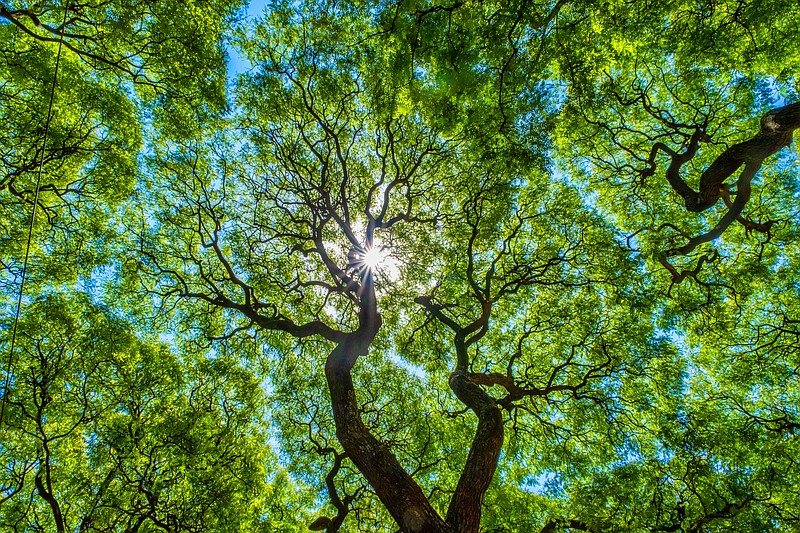Joyce Kilmer immortalized trees for most of us. He wrote:
"I think that I shall never see a poem lovely as a tree. A tree whose hungry mouth is prest against the earth's sweet flowing breast; a tree that looks at God all day, and lifts her leafy arms to pray; a tree that may in Summer wear a nest of robins in her hair; upon whose bosom snow has lain; who intimately lives with rain. Poems are made by fools like me, but only God can make a tree."
It's unlikely that Kilmer, killed as a young man by a sniper's bullet in World War I, fully understood just how vital trees are to our planet. After all, amateur scientist and women's rights activist Eunice Newton Foote had only discovered the heating value of carbon dioxide - the oxygen of trees - in the 1850s, and it would be 1938 before steam engineer and inventor Guy Callendar would connect carbon dioxide increases in Earth's atmosphere to global warming.
These days, we know more than we'd like to about CO2's effect on our earth. Our growing atmospheric shroud of heat-trapping gas carbon emissions already has resulted in a temperature rise of 2.1 degrees Fahrenheit since 1880, and scientists forecast it will rise higher still over the next century. Sea ice is melting far too fast and the global sea level has risen nearly seven inches over the past 100 years.
Trees have never been more important. Forests absorb between a quarter to 30% of all human carbon emissions annually, so these living solar energy and chemical factories towering around us are a tremendous hedge against climate change. But they need our help.
"Today, we stand exactly in a moment of destiny," two leading academics declared in a 2019 editorial about fires and deforestation in the Amazon. "The tipping point [for trees fighting climate change] is here, it is now."
Those academics could well have been talking about the forests of America, too.
The problem isn't just in burning or cutting trees. Increasingly, it's in simply keeping them alive.
In western North America, huge swaths of forested areas already are becoming unsuitable for tree regrowth owing to climate change and the fires our warming climate have spawned, researchers recently told The Guardian. In the southwestern U.S., now experiencing a "megadrought," as much as 30% of forests are at risk of converting to shrubland or another kind of ecosystem. In the Rocky Mountains, estimates hold that by 2050, about 15% of the forests would not grow back if felled by fire because the climate would no longer suit them. In Alberta, Canada, about half of existing forests could vanish by 2100.
This die-back creates its own carbon domino effect. Dead trees release all the carbon they have accumulated.
The thing is, our climate and carbon dioxide problems won't be fixed simply by planting more trees - not even millions more trees. Not only is some land becoming less hospitable to them, we simply don't have the time for them to grow up into the quantum climate change fighters that large mature trees already represent.
That means, according to Kentucky scientist, botanist and author Tom Kimmerer, we have to stop burning fossil fuels and we have to do more to save our trees - especially the big guys - the ones that store the most carbon.
"A tree is about 50% carbon (pulled in from the air and stored) And 50% to 80% of above-ground [stored] carbon is in 20% of the largest trees. What's more, those largest trees don't have to be deep in a forest. They can be in our yards, our farm fields, our city parks," Kimmerer said last month in a special zoom presentation to members of the Tennessee Valley Wild Ones, a local native plant group that aims to the "save the planet one yard at a time."
Kimmerer, author of "Venerable Trees – History, Biology and Conservation in the Bluegrass," says trees now cover about half of Tennessee - 14 million acres - and about half of Kentucky.
"But if you saw Tennessee forests 10,000 years ago, they would not look like today's forests. And the forests of future won't either," he says. "Forests are not museums. In fact, I like to say Tennessee's forests consist of recent immigrants."
He chuckles and explains: 80 to 100 years ago white bark birches would be in Tennessee's mountains but they're all gone now. Trees, he said, are constantly shifting their ranges in response to climate, and what we see as a native tree now may not be a native tree 100 years from now.
The trees didn't pick up their roots and walk, as in The Lord of the Rings. They send their unaccompanied minors with some help from birds and other animals. Blue jays, for instance, have a life-sustaining hobby: Like squirrels they pick up acorns by the hundreds and bury them for the winter. Lucky for us, they don't always remember where every acorn was left - be it in the yard or hundreds of miles away.
While the Southeast doesn't have the drought problem of the West, our trees have other enemies: encroaching development, as well as invasive species of bugs and pathogens that already have killed our chestnuts and are wreaking havoc on our hemlock, ash, elm and sassafras.
This is worrisome. Nothing is more efficient than trees and farms to store carbon.
Only God can make a tree. And only we can save or kill it.
